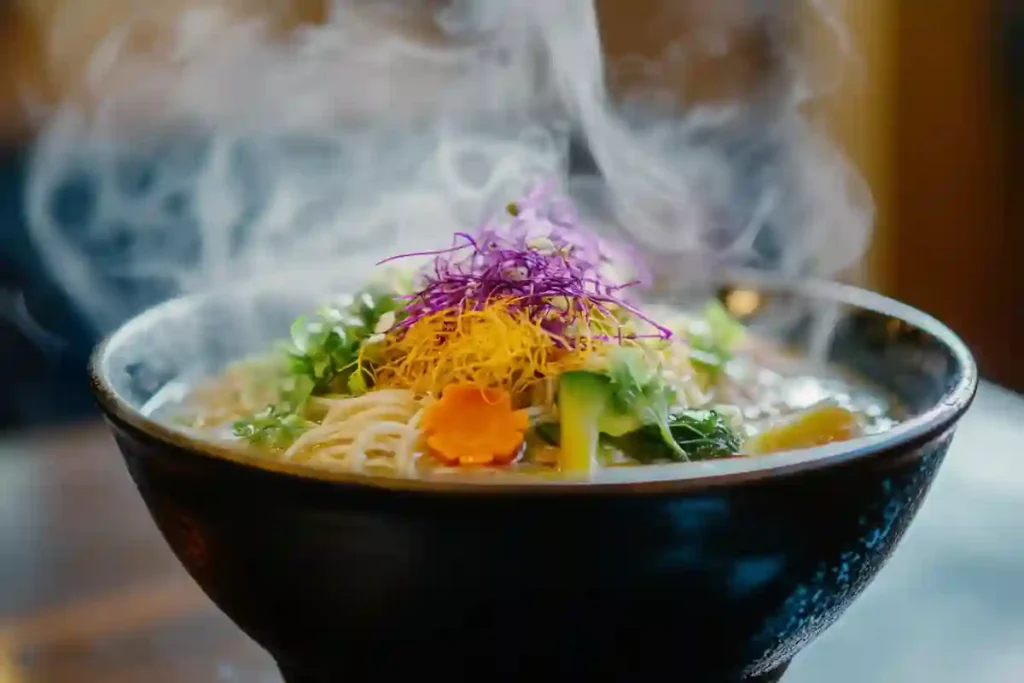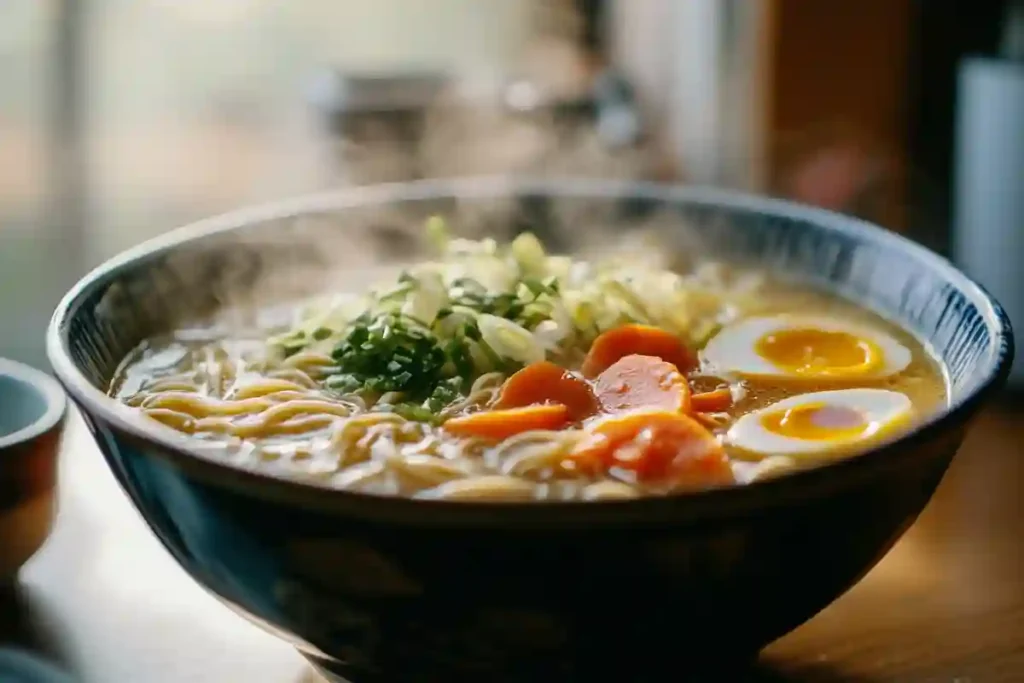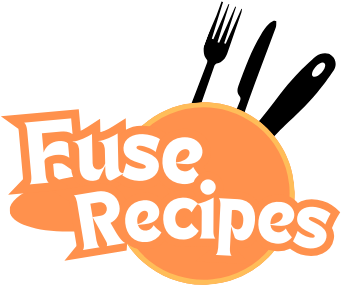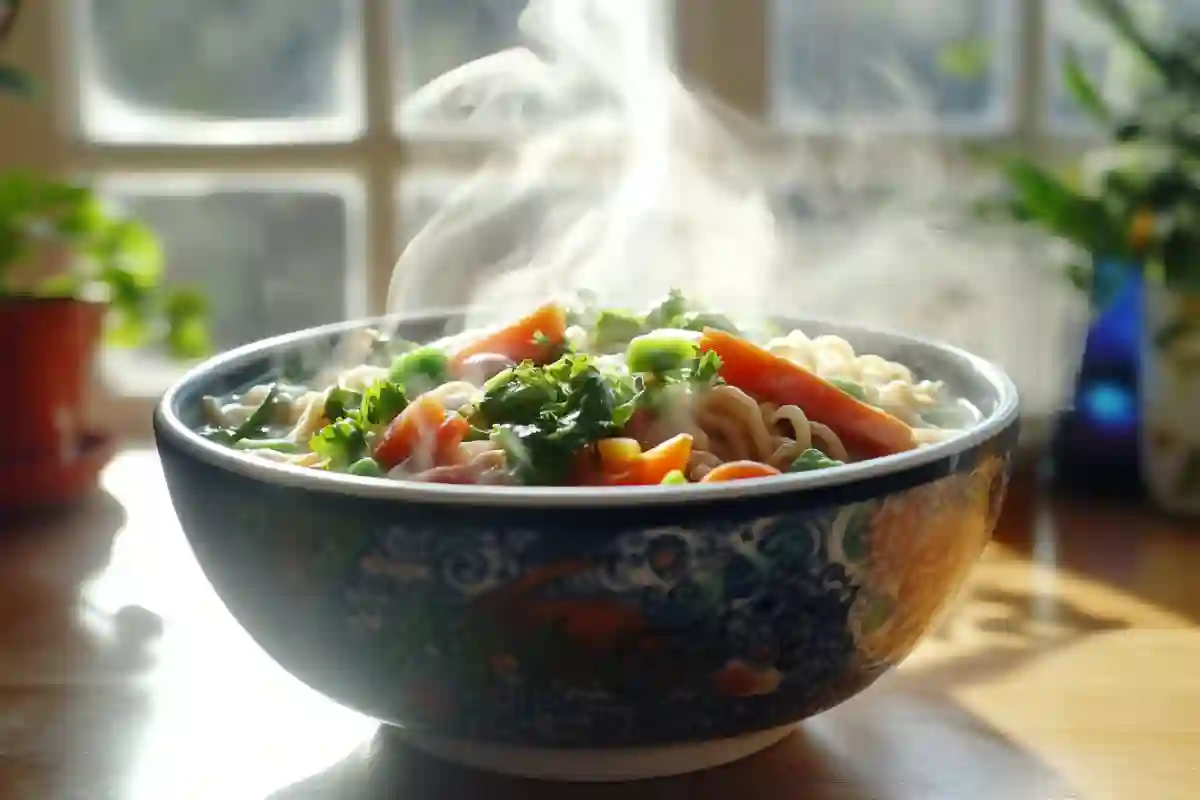Discover how to enjoy your favorite ramen dishes without gluten. This guide covers ingredients, recipes, and tips for making gluten-free ramen that everyone will love.
What is Gluten-Free Ramen?
It refers to noodle dishes that are free of gluten, a protein found in wheat, barley, and rye. Traditional ramen noodles typically contain wheat flour, making them unsuitable for individuals with gluten sensitivities or celiac disease. However, gluten-free alternatives crafted from rice, buckwheat, or other gluten-free grains make it possible to enjoy this classic comfort food without worry.

Why Choose Gluten-Free Ramen?
Choosing gluten-free ramen is more than just about avoiding gluten; it’s about embracing a healthier, more inclusive way of eating that caters to a wide range of dietary needs. Here are some compelling reasons to make the switch:
- Health Benefits: For individuals with celiac disease or gluten intolerance, avoiding gluten is essential to preventing health complications. Symptoms like digestive discomfort, fatigue, or skin issues can improve significantly by adopting a gluten-free diet.
- Inclusivity: Gluten-free ramen allows everyone, regardless of dietary restrictions, to share in the joy of this beloved dish. Whether for a family meal or a dinner party, it’s a crowd-pleaser.
- Versatility: Gluten-free ramen is highly adaptable. Whether you prefer spicy, savory, or umami-rich flavors, there’s a version of gluten-free ramen to suit your taste.
- Flavorful Options: Contrary to popular belief, gluten-free does not mean flavor-free. High-quality gluten-free noodles combined with well-seasoned broths and fresh toppings deliver an authentic ramen experience.
Noodle Alternatives
Finding the right noodles is the first step in creating delicious gluten-free ramen. Luckily, there’s no shortage of options to suit your taste and dietary requirements.
Popular Gluten-Free Noodles
- Rice Noodles:
- Made from rice flour, these noodles are naturally gluten-free.
- They have a light, slightly chewy texture and pair perfectly with traditional ramen broths.
- Buckwheat Noodles (Soba):
- Authentic soba noodles made with 100% buckwheat are gluten-free and have a distinct nutty flavor.
- Be cautious, as some store-bought soba noodles may include wheat flour, so always check labels.
- Shirataki Noodles:
- These translucent, low-calorie noodles are made from the konjac yam.
- They have a unique, springy texture and absorb the flavors of the broth beautifully.
- Chickpea or Lentil Noodles:
- Made from protein-packed legumes, these noodles add a nutritional boost to your ramen.
- They hold up well in both hot soups and cold noodle dishes.
- Zucchini Noodles (Zoodles):
- Fresh and low-carb, zoodles bring a vibrant, crunchy twist to ramen bowls.
- They’re ideal for lighter dishes or when paired with vegetable-based broths.
- Gluten-Free Packaged Ramen Noodles:
- Many brands now offer pre-made gluten-free ramen noodles, making preparation quick and convenient.
- Look for reputable brands with clean ingredient lists to avoid unnecessary additives.
Choosing the Right Noodle
The choice of noodle often depends on the type of ramen you want to create. For traditional styles like shoyu (soy sauce-based) or tonkotsu (pork broth), rice or buckwheat noodles work best. For lighter, vegetable-forward dishes, zucchini noodles or shirataki can be excellent options.
Key Ingredients
Crafting the perfect bowl of gluten-free ramen involves more than just swapping out the noodles. The broth, toppings, and seasonings play an equally critical role in delivering authentic flavors.
Broth: The Heart of Ramen
A rich, flavorful broth is the foundation of any great ramen dish. When making gluten-free ramen, ensure the broth is free from gluten-containing ingredients, such as soy sauce or wheat-based thickeners.
Bone Broth:
Made from simmering bones for hours, this broth is deeply flavorful and nutrient-rich. Additionally, it’s ideal for meat-based ramen dishes like tonkotsu or chicken ramen, making it a versatile choice for hearty meals.
Miso Broth:
Traditionally made with fermented soybean paste, miso adds a savory umami kick. However, to keep it gluten-free, always use certified gluten-free miso paste to ensure the dish remains safe for those with gluten sensitivities.
Vegetable Broth:
A lighter, plant-based option that pairs wonderfully with fresh toppings. For extra depth, add aromatics like ginger, garlic, and green onions, which can enhance the broth’s overall flavor profile.
Toppings: Customize Your Bowl
Ramen is renowned for its endless topping possibilities. For a truly satisfying experience, mix and match these options to suit your preferences:
Proteins:
- Soft-boiled eggs (Ajitsuke Tamago) for a creamy, rich texture that balances the broth’s flavors.
- Grilled chicken, pork belly (Chashu), or tofu for added protein and heartiness.
- Alternatively, shrimp or fish cakes can provide a delightful seafood twist.
Vegetables:
- Fresh greens like spinach, bok choy, or kale not only add color but also provide essential nutrients.
- Mushrooms, particularly shiitake or enoki, further enhance the umami flavors in the dish.
- Corn, bamboo shoots, or bean sprouts can also add crunchy contrasts, offering a satisfying texture.
Seasonings and Garnishes:
- Use gluten-free tamari or coconut aminos instead of traditional soy sauce for seasoning.
- If you enjoy spice, add a touch of heat with chili oil or red pepper flakes.
- Garnish with green onions, sesame seeds, or nori for extra flavor and visual appeal, completing the dish.
Essential Tips for Cooking Gluten-Free Ramen
- Cook Noodles Separately:
- Avoid overcooking gluten-free noodles by cooking them separately and adding them to the broth just before serving.
- Check for Gluten in Broth Additives:
- Common ingredients like soy sauce, miso, or stock cubes may contain gluten. Always read labels carefully.
- Layer Flavors:
- Build your broth gradually, tasting and adjusting as you go to achieve the perfect balance of flavors.
- Experiment with Toppings:
- Don’t be afraid to get creative with your toppings. Gluten-free ramen is a blank canvas for culinary exploration.
Recipes for Gluten-Free Ramen
Let’s dive into more flavorful recipes to elevate your gluten-free ramen experience. Whether you’re seeking a classic bowl or something adventurous, these recipes ensure a satisfying, customizable dish.
1. Classic
This comforting recipe is perfect for a hearty, warming meal that captures the essence of traditional ramen.
Ingredients:
- Gluten-free ramen noodles (store-bought or homemade)
- 4 cups chicken bone broth
- 2 cups shredded cooked chicken
- 1 soft-boiled egg per serving
- 1 cup baby spinach or bok choy
- 2 green onions, thinly sliced
- 1 tablespoon gluten-free tamari
- 1 teaspoon sesame oil
- 1 garlic clove, minced
- Chili oil (optional)
Instructions:
- Cook the gluten-free noodles according to the package instructions. Drain and set aside.
- Heat sesame oil in a pot over medium heat. Sauté the minced garlic until fragrant.
- Pour in the chicken broth and tamari. Bring the mixture to a simmer.
- Add shredded chicken and spinach to the broth, cooking for 2–3 minutes until warmed through.
- Divide cooked noodles into bowls. Ladle the hot broth over them.
- Top with a soft-boiled egg, green onions, and a drizzle of chili oil for a flavorful finish.
2. Vegan
This plant-based recipe brings together the umami depth of miso with fresh, vibrant vegetables for a guilt-free delight.
Ingredients:
- Gluten-free rice noodles
- 4 cups vegetable broth
- 2 tablespoons gluten-free miso paste
- 1 teaspoon ginger, minced
- 1 garlic clove, minced
- 1 cup mushrooms (shiitake or button), sliced
- 1 cup broccoli florets
- 1 carrot, julienned
- 1 cup baby bok choy
- Sesame seeds and nori strips for garnish
Instructions:
- Cook rice noodles according to package instructions. Set aside.
- In a pot, sauté garlic and ginger for 1 minute on medium heat.
- Add vegetable broth and miso paste, whisking until dissolved.
- Stir in mushrooms, broccoli, and carrots. Simmer for 5–7 minutes.
- Add bok choy and cook for another 2 minutes.
- Arrange the cooked noodles in bowls. Pour the broth and vegetables over them.
- Garnish with sesame seeds and nori strips before serving.
3. Spicy with Shirataki Noodles

This recipe is for those who love a bold, spicy kick. It’s low-carb and full of flavor.
Ingredients:
- 1 pack shirataki noodles
- 4 cups chicken or vegetable broth
- 1 tablespoon gluten-free chili paste
- 1 teaspoon ginger, minced
- 2 tablespoons coconut aminos
- 1 cup mushrooms, sliced
- 1 cup zucchini ribbons
- 1 boiled egg, halved
- Fresh cilantro and lime wedges for garnish
Instructions:
- Rinse and drain shirataki noodles. Boil for 2 minutes, then set aside.
- Heat the broth in a pot. Add chili paste, ginger, and coconut aminos.
- Stir in mushrooms and simmer for 5 minutes.
- Add zucchini ribbons, cooking for 2 minutes until tender.
- Divide shirataki noodles into bowls, then ladle the spicy broth over them.
- Top with boiled egg, cilantro, and a squeeze of lime for freshness.
4. Creamy Coconut Curry
A unique twist, this ramen combines creamy coconut milk with aromatic curry for a luxurious dish.
Ingredients:
- Gluten-free noodles (rice or chickpea)
- 1 tablespoon coconut oil
- 1 teaspoon red curry paste (gluten-free)
- 1 garlic clove, minced
- 1 teaspoon ginger, grated
- 1 can coconut milk
- 2 cups vegetable or chicken broth
- 1 cup shrimp or tofu
- 1 cup bell peppers, sliced
- Lime wedges and fresh basil for garnish
Instructions:
- Heat coconut oil in a pot. Sauté garlic, ginger, and red curry paste until aromatic.
- Add coconut milk and broth, whisking until smooth.
- Stir in shrimp or tofu and bell peppers. Simmer for 5–7 minutes.
- Cook the gluten-free noodles separately, then divide into bowls.
- Pour the creamy curry broth over the noodles and garnish with lime wedges and basil.
FAQs About Gluten-Free Ramen (With Transition Words)
1. What types of noodles can I use for gluten-free ramen?
You can choose from a variety of gluten-free noodle options, depending on your preferences and the style of ramen you want to create. For example, rice noodles are a popular choice because of their neutral flavor and chewy texture. Similarly, buckwheat noodles (100% soba) offer a nutty taste that pairs well with hearty broths. On the other hand, shirataki noodles are ideal if you’re looking for a low-carb alternative. Moreover, chickpea or lentil noodles provide extra protein and fiber. Finally, vegetable noodles, like zucchini or carrot ribbons, are excellent for lighter, fresh dishes.
2. Are all ramen broths gluten-free?
No, not all ramen broths are gluten-free. Some traditional broths may contain ingredients like soy sauce, which typically includes wheat. However, you can replace it with tamari or coconut aminos to make it gluten-free. In addition, certain miso pastes contain barley or grains, so it’s essential to check for gluten-free labeling. Finally, wheat-based thickeners might be used in some recipes, but you can use cornstarch, arrowroot, or pureed vegetables as substitutes. Always read ingredient labels carefully or, better yet, make your broth from scratch for full control.
3. Can I eat gluten-free ramen if I have celiac disease?
Yes, you can safely enjoy gluten-free ramen if you have celiac disease, as long as all ingredients are certified gluten-free and there’s no risk of cross-contamination. For instance, when cooking at home, use separate pots and utensils for gluten-free ingredients. Additionally, ensure packaged noodles and seasonings are labeled gluten-free. When dining out, always confirm that the restaurant prepares gluten-free ramen in a dedicated area.
4. What are some gluten-free alternatives to soy sauce?
Soy sauce is commonly used in ramen, but it often contains wheat. Thankfully, there are excellent gluten-free alternatives:
- Tamari: A Japanese soy sauce that is naturally gluten-free and offers a similar flavor.
- Coconut Aminos: Made from coconut sap, it is slightly sweeter but still works well in ramen recipes.
- Liquid Aminos: A protein seasoning that mimics soy sauce. However, always check the label to ensure it’s gluten-free.
- Homemade Substitute: For a simple DIY option, combine beef broth, molasses, and apple cider vinegar.
5. How can I ensure my gluten-free ramen broth has rich flavor?
Creating a flavorful broth is key to making great ramen. To start, layer flavors by sautéing garlic, ginger, and onions in sesame oil. Then, simmer the broth slowly to extract the maximum depth of flavor from bones, vegetables, or seasonings. Additionally, you can enhance the umami taste with gluten-free miso paste, tamari, or dried mushrooms. For added complexity, infuse the broth with spices like star anise or cinnamon sticks. Altogether, these techniques will ensure your broth is both rich and satisfying.
6. What toppings are suitable for gluten-free ramen?
The beauty of ramen lies in its customizable toppings. For example, proteins like grilled chicken, pork belly, or tofu can add heartiness to your dish. Alternatively, soft-boiled eggs provide a creamy texture that balances the broth’s flavors. In terms of vegetables, spinach, bok choy, kale, and mushrooms like shiitake or enoki not only add nutrition but also complement the dish’s umami profile. For a crunchy contrast, consider adding corn, bamboo shoots, or bean sprouts. Finally, season with gluten-free tamari or chili oil and garnish with sesame seeds, green onions, or nori.
7. Can I meal prep gluten-free ramen?
Yes, gluten-free ramen is perfect for meal prep. However, it’s best to store the components separately. For instance, cooked noodles should be kept in an airtight container with a bit of oil to prevent sticking. Meanwhile, refrigerate or freeze broth in individual portions for easy reheating. Additionally, keep toppings like vegetables and proteins in separate containers to maintain freshness. When ready to eat, simply reheat the broth, assemble the ingredients, and enjoy.
Conclusion
Making gluten-free ramen at home is easier than ever, thanks to a variety of noodles, broths, and toppings tailored to different preferences. Whether you’re avoiding gluten for health reasons or simply exploring new culinary options, gluten-free ramen offers a delicious way to enjoy this beloved dish without compromise.
Experiment with different noodles, from rice to shirataki, and pair them with rich broths and fresh toppings to create a unique meal every time. With this guide, you can confidently recreate your favorite ramen dishes and savor every bite, knowing they are gluten-free and wholesome.
More Delicious Recipes :
Churro Cheesecake: The Perfect Dessert for Any Occasion
Jalapeno Chips Crunchy and Spicy

